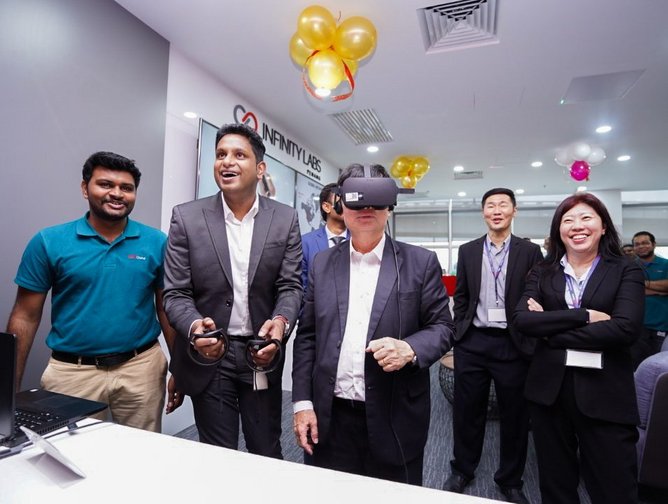UST: Building success on technology, culture, & core values
Rewind to 1999 and picture the scene. Manu Gopinath meets with the founders of a startup company called UST that dreams of becoming one of the world's most prominent and best IT organisations. Many thought this vision was ludicrous, but not Manu. He bought into the journey and became one of the believers. More than two decades later, Manu is still there, but instead of working with 20 others, he is now overseeing over 30,000 associates as the Chief Operating Officer. As for UST, it is now well over a billion-dollar revenue company certified as a Top Employer of the Year in North America, APAC, the UK & Spain. Manu has played a pivotal role in that meteoric rise.
"We've had an amazing run over the last 22 years," recalls Manu. "UST was set up with the ambitious goal to transform lives. I remember interviewing with our founders, and they were talking about building the best IT company in the world. We had nothing but big ambitions."
You could argue that is the exact position that every startup finds itself in – global ambitions and dreams of becoming the Next Big Thing. Many dreams are quickly shattered, with a staggering 90% failing and 10% failing within the first 12 months. So, what made UST different? What's the secret to their success? Manu puts it down to the foundational values and culture.
"To be honest, I wasn't fully convinced that we were going to build the best IT company," says Manu. "But what changed was every step of the way, the founders made that vision happen. The big focus was on building the foundational values and culture of the company – even before customers or projects came in, and that was the major focus."
Pivot is a word we have heard a lot in the last two years as organisations have had to reassess aspects of their business just to survive. For UST, it was not the first time. The company was formed and was taking its first steps when the dot.com bubble burst at the turn of the new millennium. It's worth refreshing our memories on some stats from that crazy time. With computers and the internet taking off, investors clamoured for a slice of the action. In 1999, shares in semiconductor company Qualcomm rose, wait for it, by 2,619%. A dozen other companies saw their shares rise more than 1,000%. The Nasdaq 100 lost 78% of its value when the bubble burst. It was a time when UST realised it had to change its strategy.
"During the first Dot.com boom, our goal was to provide the up-and-coming startups with cutting-edge technology solutions. But we soon realised that by the time we invoiced, many of these Dot.coms had perished because the venture money ran out," remembers Manu.
"We had to reinvent ourselves and say, 'how do we pivot from here?' And we did that. We said we are going after large, global 1000 and Fortune 500 enterprises with sustainable budgets. So that's the goal we set out, and we had some early success.
"We were just a blip on the radar for many of them because they had big-scale service providers. We grew because we provided excellent execution and delivered services on time and with quality."
Even though they were relatively small, UST soon saw repeat business coming. Manu says it is because the clients liked what they did and trusted UST "to do what is right".
Manu also puts UST's success down to its passionate engineers who go the extra mile to deliver brilliant outcomes for clients. The technology inevitably evolves, and UST's learning agility sets them apart from the big-name competition.
"It's about understanding what the customer needs to move the needle," he says, "to be a differentiator in the market. Our engineers are young, dynamic, and focused on learning. They were able to figure out solutions and upskill to deliver work for clients – taking a long-term view on the client relationship."
That approach has clearly paid dividends, with the average tenure of each customer being 13 years with UST. That has also enabled UST to focus on around 150 valued Fortune 500 and Global 1000 companies. This focus on the customer has helped UST come a long way.
NURTURING TALENT
Building a team means being able to spot talent, and Manu, as Chief People Officer until 2019, set the stage for UST's talent transformation.
"Talent is the cornerstone for any kind of competitive advantage and, in technology business especially, talent has a lot of choices," says Manu.
"Talent is critical because they compete and win against the competition at the end of the day. UST's strength lies with its talent, which means individuals in the company compete against individuals in other organisations to win business."
One person who spotted talent in the young Manu Gopinath back in 1999 was Founder Chairman, the late G.A. Menon, who made an impact and who Manu describes as an incredible human being. He was also a brilliant businessman, building eight businesses, many of which are over a billion-dollar revenue.
"He has been a phenomenal inspiration in terms of how we should think about business, people, and technology. He was a visionary," says Manu. "If you look at UST's foundational values, we distilled that from all the different conversations Mr. Menon had with employees. Unfortunately, he passed away in 2003, but that spirit still lives on in UST."
Specific advice Manu garnered from Mr. Menon included focusing on creating value, focusing on what matters, and trying to make every employee an expert in the organisation.
"Our core values remain humility, humanity, and integrity," says Manu. "And those things have come directly from Mr. Menon's influence on the entire UST organisation."
BUILDING RESILIENCE
Resilience is another essential quality that a successful, sustainable company needs in abundance. It is also an elusive characteristic that can be hard to identify and even harder to achieve. So how do you build resilience in an organisation? Manu believes there are several factors, but it all comes down to "purpose".
"Creating that larger purpose is important," he says. "Then getting your employees to believe in that organisation and that purpose is super important. Taking that long-term view is important to move the needle."
Manu adds that it's also essential when designing a product, service, or solution to ensure that it helps the end consumer and that you are thinking about them, not just the engineering.
Then, of course, there is technology everywhere and in everything. Technology needs to be applied to understand and empathise with the end-user or consumer. Another essential element to building resilience is learning agility and learning capability.
"We live in a super dynamic world, and nobody can predict what's coming next," admits Manu. “The ability to learn quickly. Ability to adapt. The ability to pivot so that your business can grow is critical to bring resilience and build resilience into an organisation."
In a recent White Paper, Manu discussed the six guiding principles of a resilient enterprise, and it is worth sharing that insight here.
"Pretty much every business is trying to go digital to build a resilient enterprise," says Manu. "When the pandemic struck, companies who had the digital storefront had a better chance of succeeding and growing. Companies that have embraced digital have reacted better in the face of adversity.
"The other piece is looking at security and taking steps to mitigate cyber-attacks. For example, if you look at Facebook, they hold billions of personal data, and they are attacked every moment. It's not a question of whether Facebook is being attacked – they are being attacked every minute, so it's a question of how they plan and mitigate the risk, and I think that is critical."
Thirdly, Manu highlights the need for organisations to be lean and agile, to be able to move quickly. Fourthly, and this relates well to UST itself, the purpose is key. Having a purpose and ensuring that your customers, your employees, and the communities you operate in know your purpose is essential. That would also help to build resilience.
"The other piece is building an ecosystem," says Manu. "No company can thrive independently, and even the largest companies need suppliers and an ecosystem. We look at it from the perspective that the customers are important, our communities are important, our employees are important, and all of our ecosystem, our partners, are very important.
"You cannot operate in a vacuum and be successful. Companies connected to an ecosystem can manage the shocks and manage the risks."
DELIVERING DIGITAL TRANSFORMATION
UST has built a glowing reputation for helping leading organisations with their digital transformations, no matter how large or complex. Many organisations find this transformation a struggle, so they turn to UST.
"The key to digital transformation is to make sure that there is a change in culture and mindset in an organisation," says Manu. "If your employees and your leadership do not have a mindset to adapt, change and look at new ways of doing things, the transformation will not help."
UST focuses on creating a fantastic customer and employee experience, leveraging the tools and solutions they already have. They help to put together the strategy, the design, the development, the maintenance, and even the architecture. Then UST optimises the business processes so the organisation can be resilient and agile. Another area where UST helps clients to future proof their business is via its extensive partner ecosystem.
"We are proud to have some of the best technologists globally, and they are proud to serve and help our clients," says Manu. "That's a big factor that makes UST the go-to provider for many of our clients."
As a company, UST is working towards being a partner of choice for some of the world's best companies, helping them create a competitive advantage by leveraging technology. UST also strives to be an employer of choice for the best-in-class talent from around the world, plus provide the ecosystem of choice.
"We are focused on building products and platforms that help enterprises solve their business problems," says Manu. "We are passionate about helping our clients transform their business.
"The best thing about working at UST is the flexibility and the freedom to do the best you can. Unleash your imagination and creativity, and you will get support from the organisation, and you get to turn those ideas into reality."




- Manu Gopinath


